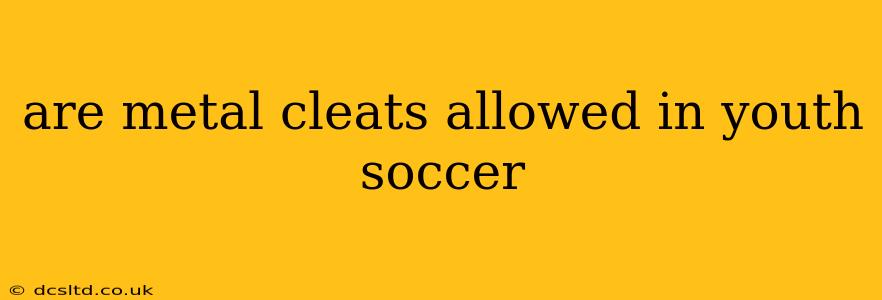The question of whether metal cleats are allowed in youth soccer is a common one, sparking debate among parents and coaches alike. The answer, however, isn't a simple yes or no. It depends heavily on the specific league, organization, and even the age group of the young players. This guide will delve into the nuances of this topic, providing clarity and helping you navigate the rules surrounding footwear in youth soccer.
What are the Different Types of Soccer Cleats?
Before addressing the metal cleat question directly, let's clarify the types of soccer cleats available:
- Metal Cleats: These feature metal studs or spikes, offering superior grip on firm ground. However, their potential for causing injury is a major concern.
- Plastic Cleats: These cleats utilize plastic studs, offering a good balance between grip and safety. They are generally preferred for youth soccer due to their reduced injury risk.
- Combination Cleats: Some cleats blend metal and plastic studs. The presence of metal studs, even if only a few, can trigger restrictions.
- Firm Ground (FG) Cleats: Designed for dry, firm surfaces. They can have metal, plastic, or a combination of both.
- Soft Ground (SG) Cleats: Have longer studs, ideal for softer, muddy pitches. These typically feature metal studs, but increasingly offer plastic alternatives.
- Artificial Grass (AG) Cleats: Shorter studs designed specifically for artificial turf. Usually made of plastic.
Are Metal Cleats Allowed in My Youth Soccer League?
This is the crucial question. There is no universal rule regarding metal cleats in youth soccer. The governing body of your specific league (e.g., your local recreational soccer association, a national youth soccer organization) will dictate the permitted footwear.
Your first step should always be to check your league's rules and regulations. These are typically outlined in a rulebook or handbook available on the league's website or from your coach. Look for sections on equipment or player safety. If you can't find the information, contact the league administrator or your child's coach directly.
Why the Restrictions on Metal Cleats in Youth Soccer?
The primary reason for restrictions on metal cleats in youth soccer is safety. Metal cleats can cause significantly more serious injuries than plastic cleats, particularly in the event of a tackle or accidental collision. The increased risk of cuts, scrapes, and more severe wounds is a key concern for younger players whose bodies are still developing.
What are the Consequences of Wearing Metal Cleats When Prohibited?
The consequences for wearing prohibited metal cleats vary depending on the league. This could range from a warning to a suspension from the game or even the season. It's crucial to comply with the league's rules to avoid any disciplinary action.
H2: What are some alternatives to metal cleats for my child?
Several safe and effective alternatives to metal cleats exist for youth soccer players:
- Plastic cleats (FG): These are the most common and widely accepted choice for young players. They provide excellent traction without the risk associated with metal studs.
- AG cleats: If your child plays on artificial turf, these are specifically designed to minimize injury risk and maximize performance.
Choosing the right cleat type is essential for safety and comfort. Remember to check your league's rulebook for clarity and discuss any doubts with league officials or your child's coach.
H2: What age groups are typically restricted from using metal cleats?
The age restrictions on metal cleats often vary from league to league. However, it's not uncommon for leagues to prohibit metal cleats for younger age groups (e.g., U8, U10). As players get older and their skill level improves, along with the greater emphasis on safety protocols, the chances of using metal cleats increase. Always check your league's regulations for definitive information.
H2: Where can I find the rules for my local youth soccer league?
The best way to find the rules is to visit your league's official website. This should be listed on any registration materials or communications you've received. Look for a section on rules and regulations, player guidelines, or equipment guidelines. If you are unable to find the information, contact the league administrator or coach directly. They will be able to provide you with a definitive answer.
In conclusion, while the use of metal cleats in youth soccer is sometimes permitted, it's far more common for leagues to prohibit them, prioritizing the safety of young players. Always check your league's specific rules before purchasing cleats for your child to ensure compliance and avoid potential issues. Remember, player safety should always be the top priority.
